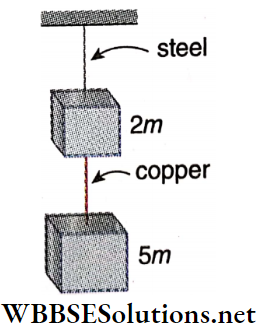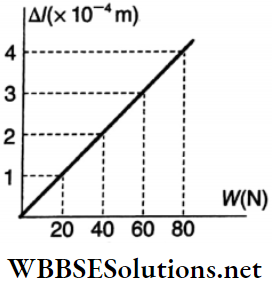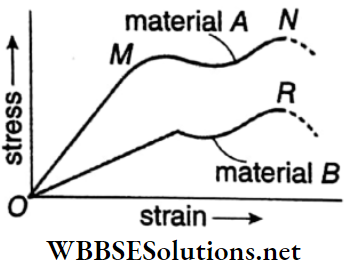Elasticity Multiple Correct Answers Type Questions
Question 1. The most elastic among the following substances is
- Rubber
- Glass
- Steel
- Copper
Answer: 3. Steel
Question 2. Which is most elastic?
- Iron
- Copper
- Quartz
- Wood
Answer: 3. Quartz
Question 3. The ratio of the lengths of two wires made of the same metal and of equal radius is 1:2. If both the wires are stretched by the same force, then the ratio of the strains will be
- 1:1
- 1:2
- 2:1
- 1:4
Answer: 1. 1:1
Question 4. Shearing strain is expressed by
- Shearing force
- Angle of shear
- Increase in area
- Decrease in volume
Answer: 2. Angle of shear
Question 5. Breaking the stress of a wire depends on
- The radius of the wire
- The length of the wire
- The shape of the cross-section
- The nature of its material
Answer: 4. The nature of its material

Question 6. The elongation of an elastic material is very low. What should be the shape of a body for which the longitudinal strain will be appreciable?
- A thin but long wire
- A thick block having any cross-section
- A thin block having a rectangular cross-section
- A thin and short wire
Answer: 1. A thin but long wire
Question 7. The unit of elastic modulus is
- N · m-3
- N · m-2
- N · m-1
- N · m
Answer: 2. N · m-2
Question 8. Four wires made of the same metal are stretched by the same load. Their dimensions are given below. Which one will be elongated most?
- Length 1 m, diameter 1 mm
- Length 2 m, diameter 2 mm
- Length 3 m, diameter 3 mm
- Length 4 m, diameter 0.5 mm
Answer: 4. Length 4 m, diameter 0.5 mm
Question 9. Keeping the length of a wire unchanged, its diameter is doubled. Young’s modulus for the material of the wire will
- Increase
- Decrease
- Remain the same
- None of these
Answer: 3. Remain the same
Question 10. Keeping one end of a wire of length L and radius r fixed, a force F is applied at the other end to elongate it by l. Another wire made of same metal but of length 2 L and radius 2r is stretched by a force 2 F. Its increase in length will be
- l
- 2l
- l/2
- 4l
Answer: 1. l
Question 11. The ratios of the lengths and diameters of two metallic wires A and B of the same material are 1: 2 and 2 :1 respectively. If both the wires are stretched by the same tension, then the ratio of the elongations of A and B will be
- 1:2
- 4:1
- 1:8
- 1:4
Answer: 3. 1:8
Question 12. A uniform rod weighs W, has a length L and has a cross-sectional area a. The rod is suspended from one of its ends. The Young’s modulus of its material is Y. An Increase in length of the rod will be
- zero
- \(\frac{W L}{2 a Y}\)
- \(\frac{W L}{a Y}\)
- \(\frac{2 W L}{a Y}\)
Answer: 2. \(\frac{W L}{a Y}\)
Question 13. If the ratio of diameters, lengths and Young’s modulus of steel and copper wires shown in the Fig are p, q and s respectively, then the corresponding ratio of increase in their lengths would be

- \(\frac{5 q}{7 s p^2}\)
- \(\frac{7 q}{5 s p^2}\)
- \(\frac{2 q}{5 s p}\)
- \(\frac{7 q}{5 s p}\)
Answer: 2. \(\frac{7 q}{5 s p^2}\)
Question 14. Two rods of equal length and cross-sectional area have their Young’s moduli Y1 and Y2 respectively. If the rods are joined end to end, then the equivalent Young’s modulus of the combined rod system is
- \(\frac{2 Y_1 Y_2}{Y_1+Y_2}\)
- \(\frac{Y_1 Y_2}{Y_1+Y_2}\)
- \(\frac{1}{2\left(Y_1+Y_2\right)}\)
- \(Y_1+Y_2\)
Answer: 1. \(\frac{2 Y_1 Y_2}{Y_1+Y_2}\)
Question 15. A rubber string of length 8 m is hanging vertically with one end fixed. If the density of rubber is 1.5 x 103 kg · m-3 and Young’s modulus is 5 x 106 N · m-2, then the increase of its length due to its own weight will be [g = 10 m · s-2]
- 9.6 x 10-2 m
- 19.2 x 10-3 m
- 9.6 x 10-3 m
- 9.6 m
Answer: 1. 9.6 x 10-2 m
Question 16. The modulus of rigidity of steel is n and its Young’s modulus is Y. A steel wire of cross-sectional area A is so elongated that its area of cross-section becomes A/10. As a result
- Y increases but n decreases
- Y and n both remain the same
- Y decreases but n increases
- Both Y and n will increase
Answer: 2. Y and n both remain the same
Question 17. One end of a wire of length 1 m is rigidly fixed at the ceiling and a load W is applied at the other end of it. Load-elongation graph of it is shown in the diagram. If the area of the cross-section of the wire is 10-6 m2, then Young’s modulus for the material of the wire will be

- 2 x 1011 N · m-2
- 2 x 10-11 N · m-2
- 3 x 1012 N · m-2
- 2 x 10-13 N · m-2
Answer: 1. 2 x 1011 N · m-2
Question 18. In stretching a wire, the amount of work done per unit volume of the wire is
- Stress x strain
- 1/3 x strees x strain
- \(\frac{stress}{strain}\)
- 1/2 x strees x strain
Answer: 4. 1/2 x strees x strain
Question 19. A stretched rubber has
- Increased kinetic energy
- Increased potential energy
- Decreased kinetic energy
- Decreased potential energy
Answer: 2. Increased potential energy
Question 20. A wire of initial length L and area of cross-section A has Young’s modulus Y of its material. The wire is stretched by a stress S within its elastic limit. The stored energy density in the wire will be
- \(\frac{S}{2 Y}\)
- \(\frac{2 Y}{s^2}\)
- \(\frac{s^2}{2 Y}\)
- \(\frac{S^2}{Y}\)
Answer: 3. \(\frac{s^2}{2 Y}\)
Question 21. A wire of initial length L and area of cross-section A, having Young’s modulus Y of its material, is stretched to be elongated by an amount x. Work done in stretching the wire is
- \(Y A \frac{x^2}{2 L}\)
- \(Y A \frac{x^2}{L}\)
- \(Y A \frac{x}{2 L}\)
- \(Y A \frac{2 x^2}{L}\)
Answer: 1. \(Y A \frac{x^2}{2 L}\)
Question 22. One end of a wire is rigidly fixed and a force of 200 N is applied at its other end. The wire undergoes an elongation of 1 mm. The potential energy stored in the wire is
- 0.1 J
- 0.2 J
- 10 J
- 20 J
Answer: 1. 0.1 J
Question 23. Two wires A and B are made of the same metal. The diameter of A is double that of B and the length of B is thrice that of A. If both the wires are stretched by the same force to elongate them equally within elastic limit, then the ratio of energy stored in the wires A and B will be
- 2:3
- 3:4
- 3:2
- 6:1
Answer: 2. 3:4
Question 24. A spring of force constant k is cut into two equal parts. The force constant of each part of the spring will be
- k/2
- k
- 2k
- 4k
Answer: 3. 2k
Question 25. Force constants of two springs are k1 and k2. One end of a spring is connected with one end of the other. The equivalent force constant of the spring system will be
- \(\frac{k_1+k_2}{2}\)
- \(2\left(k_1+k_2\right)\)
- \(\frac{k_1+k_2}{k_1 k_2}\)
- \(\frac{k_1 k_2}{k_1+k_2}\)
Answer: 4. \(\frac{k_1 k_2}{k_1+k_2}\)
Question 26. A wire of length L and area of cross-section A, having Young’s modulus Y of its material, behaves like a spring of force constant k. The value of k will be
- \(k=\frac{Y A}{L}\)
- \(k=\frac{2 Y A}{L}\)
- \(k=\frac{Y A}{2 L}\)
- \(k=\frac{Y L}{A}\)
Answer: 1. \(k=\frac{Y A}{L}\)
Question 27. An elastic spring of length L and of force constant k is stretched to increase its length by an amount x. The spring is further stretched to elongate it by y. The amount of work done in stretching the spring in the second case (x and y are very small) is
- \(\frac{1}{2} k y^2\)
- \(\frac{1}{2} k\left(x^2+y^2\right)\)
- \(\frac{1}{2} k(x+y)^2\)
- \(\frac{1}{2} k y(2 x+y)\)
Answer: 4. \(\frac{1}{2} k y(2 x+y)\)
Question 28. An ideal spring with spring constant k is hung from the ceiling and a block of mass M is attached to its lower end. The mass is released when the spring is initially unstretched. Then the maximum extension in the spring is
- \(\frac{4 M g}{k}\)
- \(\frac{2 M g}{k}\)
- \(\frac{M g}{k}\)
- \(\frac{M g}{2 k}\)
Answer: 2. \(\frac{2 M g}{k}\)
Question 29. TWo springs P and Q of force constant kP and kQ \(\left(k_Q=\frac{k_P}{2}\right)\) are stretched by applying forces of equal magnitude. If the energy stored in Q is E, then the energy stored in P is
- E
- 2 E
- E/4
- E/2
Answer: 4. E/2
Question 30. Before snapping, a wire can bear a load of 100 kg. The wire is cut into two equal parts. Now the maximum load that can be withstood by each part of the wire is
- 100 kg
- 40 kg
- 200 kg
- 50 kg
Answer: 1. 100 kg
Question 31. A uniform wire of length I and weight W is rigidly fixed at one end and a load W1 is applied at its other end. If the area of cross-section of the wire is S, then stress developed in the wire at a distance 3L/4 from its lower end will be (assume that increase in length of the wire is very small)
- \(\frac{W_1}{S}\)
- \(\frac{\left(\frac{3 W}{4}\right)}{S}\)
- \(\frac{\left(W_1+\frac{3 W}{4}\right)}{S}\)
- \(\left(\frac{W_1+\frac{W}{4}}{S}\right)\)
Answer: 3. \(\frac{\left(W_1+\frac{3 W}{4}\right)}{S}\)
Question 32. A steel ring of radius r and cross-section A is fitted onto a wooden disc of radius R(R> r). If Young’s modulus be E, then the force with which the steel ring is expanded is
- \(A E \frac{R}{r}\)
- \(\frac{E r}{A R}\)
- \(\frac{E}{A}\left(\frac{R-r}{A}\right)\)
- \(A E\left(\frac{R-r}{r}\right)\)
Answer: 4. \(A E\left(\frac{R-r}{r}\right)\)
In the type of questions more than one options are correct.
Question 33. A wire of length L and cross-section A hung from a rigid support is loaded with a mass M. The elongation produced is
- Inversely proportional to L
- Directly proportional to M
- Directly proportional to young’s modulus
- Inversely proportional to A
Answer:
2. Directly proportional to M
4. Inversely proportional to A
Question 34. Which of the following statements are correct regarding elasticity?
- Rubber does not obey Hooke’s law
- Elasticity can be different for tensile and compressive stress
- Elasticity is independent of temperature
- Poisson’s ratio is a modulus of elasticity
Answer:
1. Rubber does not obey Hooke’s law
2. Elasticity can be different for tensile and compressive stress
Question 35. Potential energy per unit volume of a stretched wire is
- 1/2 stress x strain
- \(\frac{1}{2} \frac{\text { stress }}{\text { strain }}\)
- 1/2 Young’s modulus x strain2
- 1/2 x Young’s modulus x strain
Answer:
1. 1/2 stress x strain
2. \(\frac{1}{2} \frac{\text { stress }}{\text { strain }}\)
Question 36. Two wires A and B have equal lengths and are made of the same material, but the diameter of A is twice that of wire B. Then, for a given load
- The extension of B will be four times that of A
- The extension of A and B will be equal
- The strain in B is four times that in A
- The strain in A and B will be equal
Answer:
1. The extension of B will be four times that of A
3. The strain in B is four times that in A
Question 37. The figure shows the stress-strain graphs for materials A and B. From the graph it follows that

- Material A has a higher Young’s modulus
- Material B is more ductile
- Material B can withstand greater stress
- Material A can withstand greater stress
Answer:
1. Material A has a higher Young’s modulus
4. Material A can withstand greater stress
Question 38. Two wires A and B have the same cross-section and are made of the same material but the length of wire A is twice that of B. Then for a given load
- The extension of A will be twice that of B
- The extension of A and B will be equal
- The strain in A will be half that in B
- The strains in A and B will be equal
Answer:
1. The extension of A will be twice that of B
4. The strains in A and B will be equal
Question 39. Choose the correct statement (s) from the following.
- Steel is more elastic than rubber
- The stretching of a coil spring is determined by the Young’s modulus of the wire of the spring
- The frequency of a tuning fork is determined by the shear modulus of the material of the fork
- When a material is subjected to a tensile (stretching) stress the restoring force is caused by interatomic attraction
Answer:
1. Steel is more elastic than rubber
4. When a material is subjected to a tensile (stretching) stress the restoring force is caused by interatomic attraction

